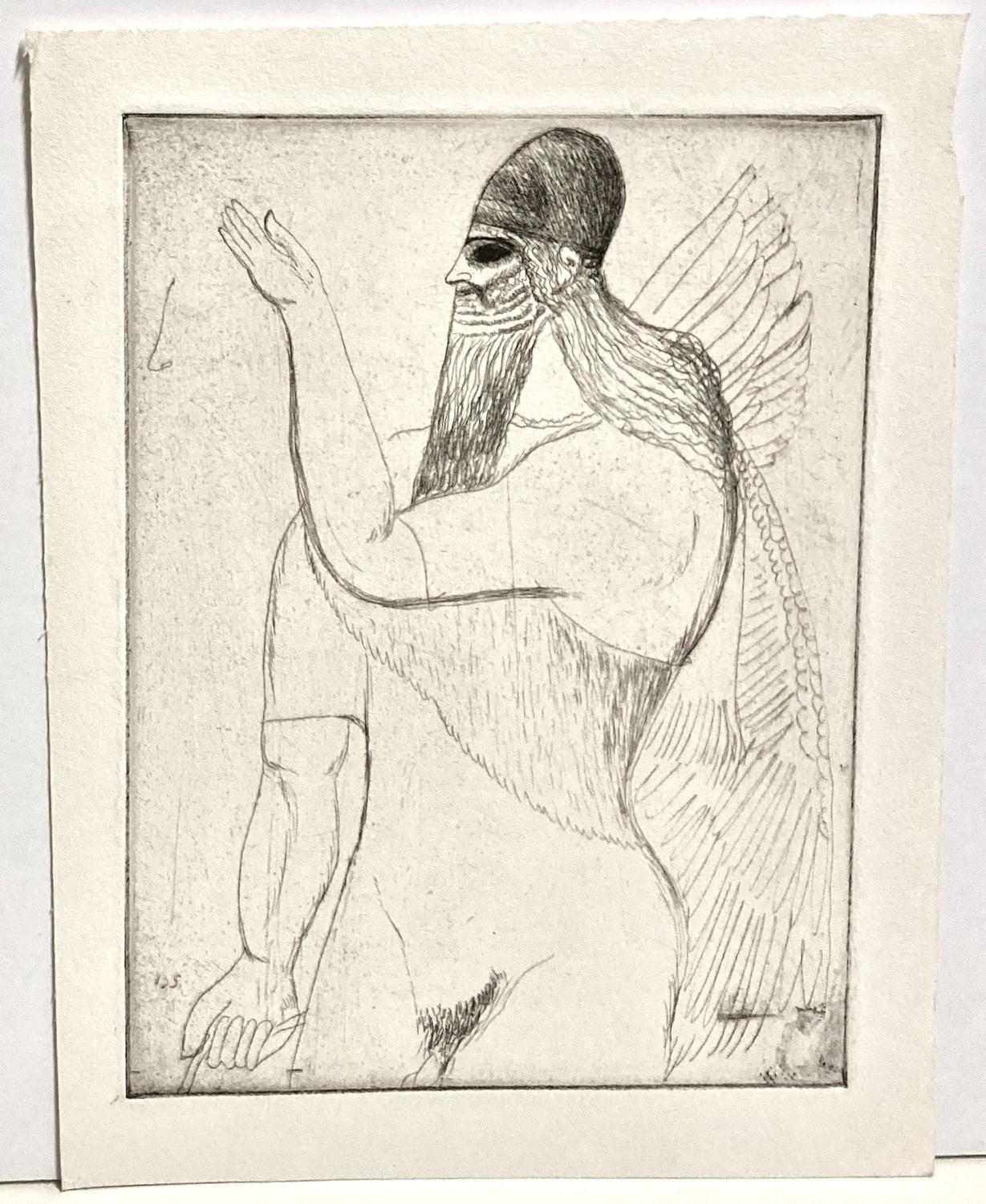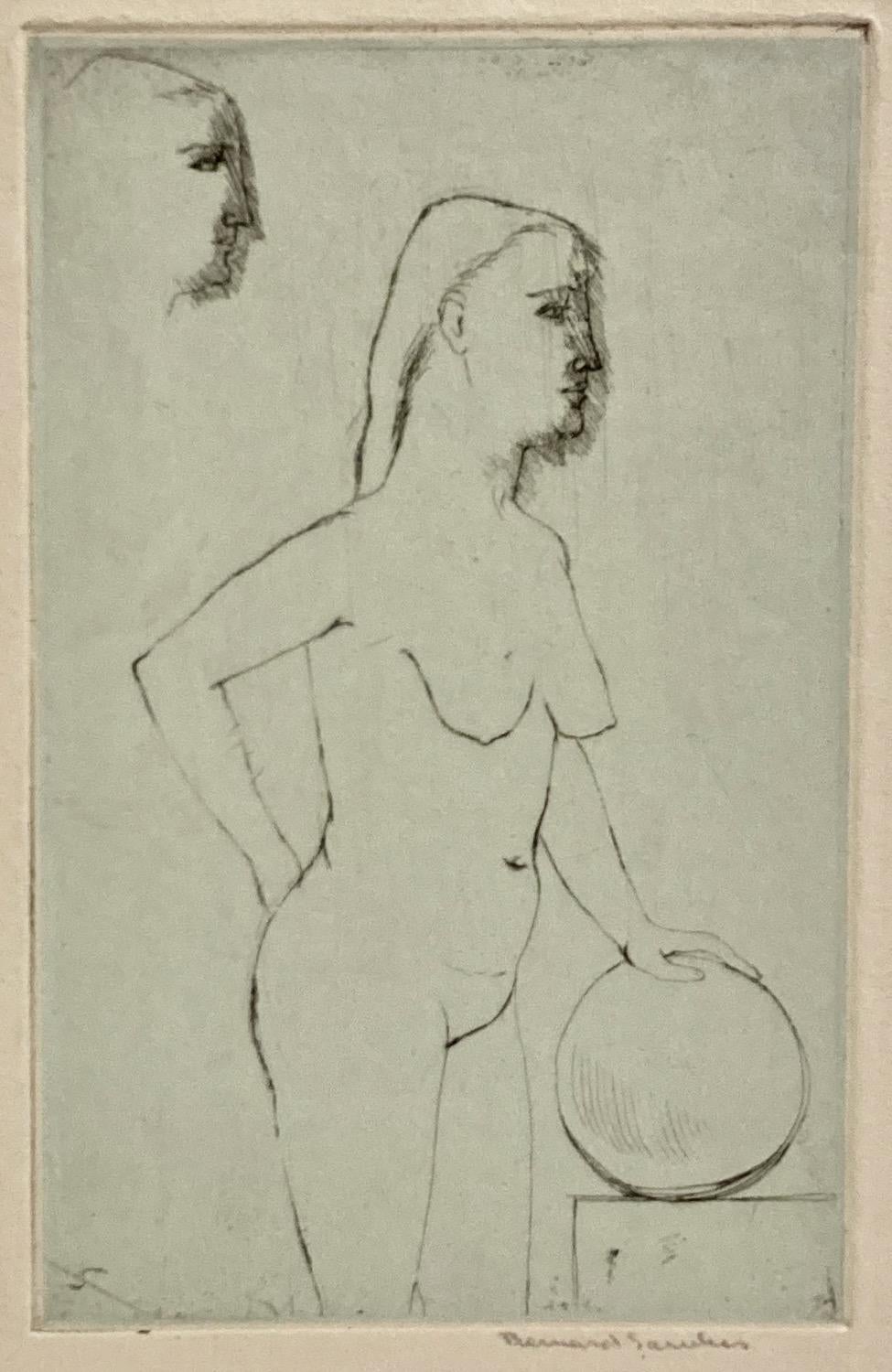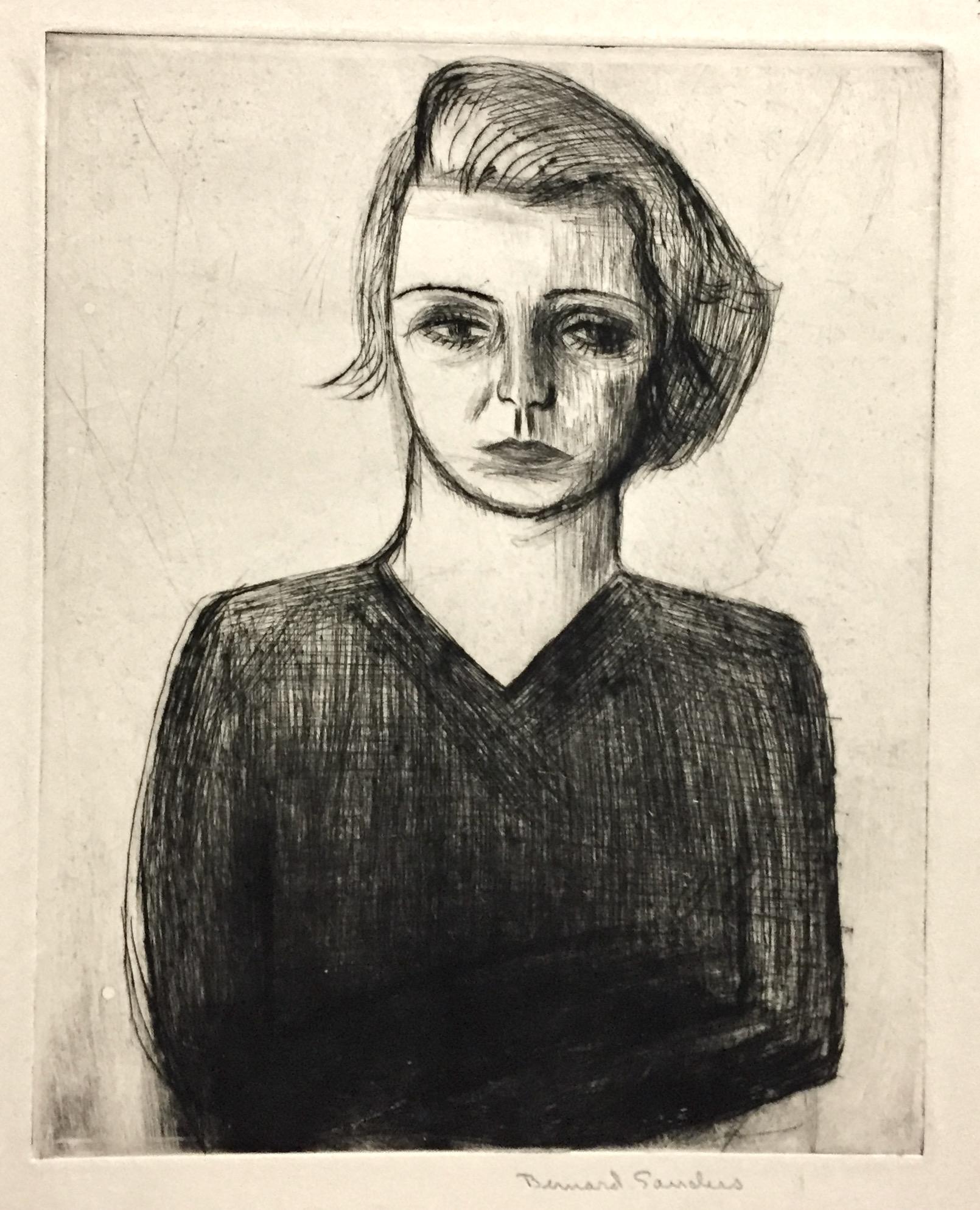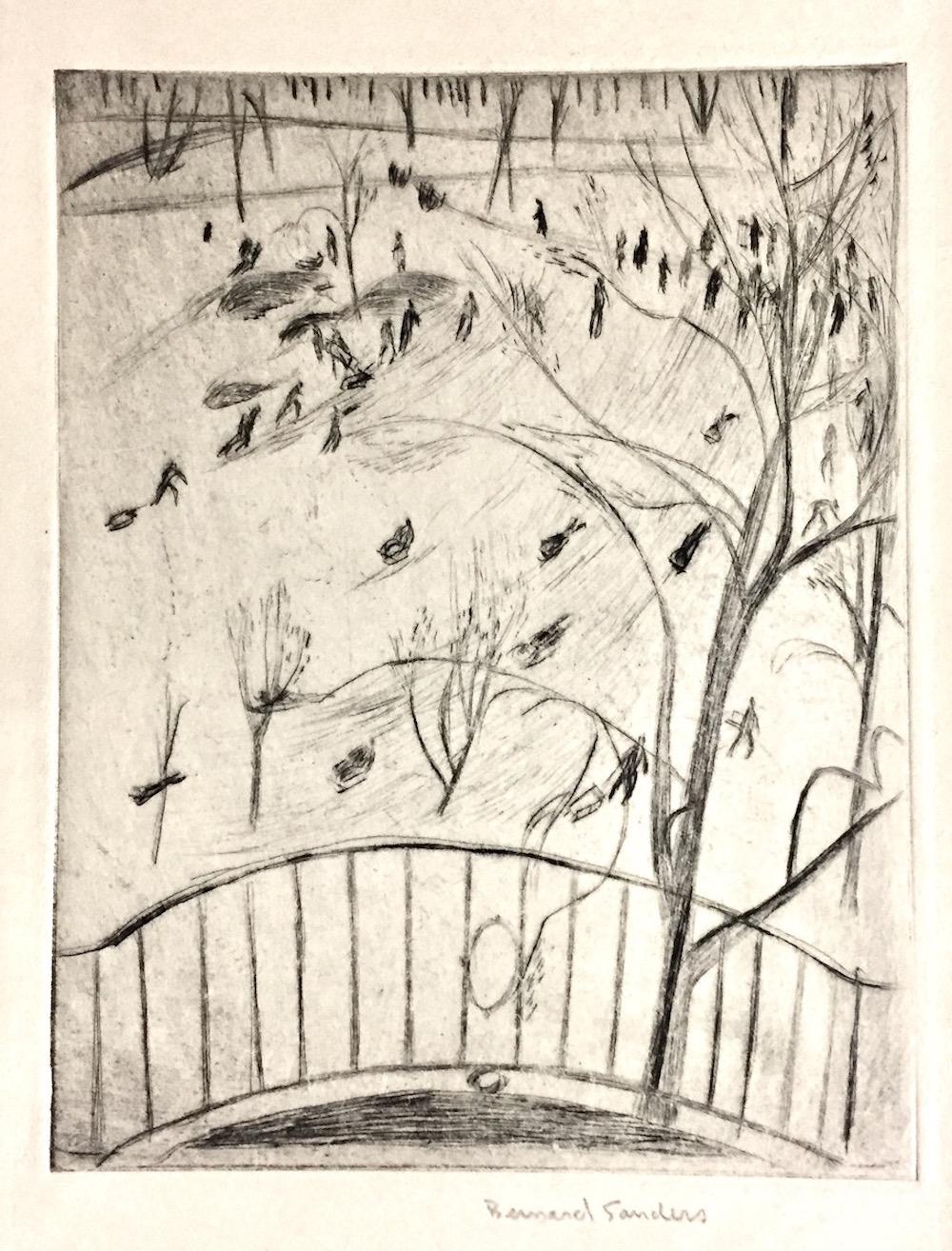Items Similar to Profile Bust of a Girl - Woman's Head in Profile (Havard)
Want more images or videos?
Request additional images or videos from the seller
1 of 6
Elie NadelmanProfile Bust of a Girl - Woman's Head in Profile (Havard)1920
1920
About the Item
Profile Bust of a Girl - Woman's Head in Profile (Havard)
Drypoint, 1920
Unsigned (as issued)
From: The Drypoints of Elie Nadelman, 21 unpublished prints by the sculptor, proof from the original zinc and copper plates, 1952
Published by Curt Valentin, New York
Edition: unknown
Printed by Charles S. White, mast printer
Printed on a simili japan paper
A complete portfolio is in the collection of Harvard Art Museums
Only a very few impressions of llifetime impressions by Nadelman are known. Even these posthumous impressions from 1952 are rare today.
Reference: Kirstein 15, published state
Condition: Very minor printer's creases
Plate/Image size: 4 5/8 x 3 3/16 inches
Elie Nadelman
Born 1882, Warsaw, Poland
Died 1946, Bronx, New York
Born in occupied Poland, Elie Nadelman began his artistic training in Warsaw before leaving in 1902 to visit Munich, where he developed a passion for early Greek art. In 1905, soon after joining the Polish colony in Paris, he made his debut at the Salon d’Automne. When World War I broke out, Nadelman emigrated to New York with the help of his patron, Helena Rubinstein, and began to introduce genre subjects, such as popular dance, into his repertoire. He married Viola Spiess Flannery in 1919, and together they built the country’s largest collection of folk art, part of which was later documented by the Index of American Design. Consisting of more than 50,000 artifacts, the collection was unique in the US at the time for its inclusion of European objects. In 1926 their Museum of Folk and Peasant Arts opened in Riverdale in the Bronx. After the museum closed in 1937 due to lack of funds, Nadelman stopped exhibiting publicly, although he remained dedicated to his art. He committed suicide in 1946.
Despite his affinity for vernacular subjects, Nadelman was mainly celebrated for the stylized, streamlined grace of his Greek-inspired works. While his classical sculptures garnered an enthusiastic uptown collector base, the plaster genre figures he exhibited downtown beginning in 1917, followed soon by cherrywood and bronze versions, attracted only controversy. Nadelman’s disregard for the boundaries between high and low was also expressed in the organization of his folk art collection, which highlighted formal correspondences across time and space. His passion for folk art later inspired his largely unrealized ambition to produce works for a popular audience. To this end, in the late 1920s he replicated the look of bronze sculpture with more affordable galvano-plastique and made ceramic multiples with individualized touches and inventive patinas.
Dancer (1918) was the only one of Nadelman’s cherrywood vernacular figures to sell during his lifetime. Arranged in a pose reminiscent of Georges Seurat’s Le Chahut (1889–1890), its smooth and simplified wood surfaces are economically defined with a few touches of color. The fleshiness of Nadelman’s glazed ceramic and painted papier-mâché figures of the 1930s represents an increasing transgression of the values that defined his early classical sculptures, then taken further in the palm-sized plaster sculptures he produced beginning in 1938."
Courtesy National Gallery of Art, Washington
- Creator:Elie Nadelman (1885-1946, Polish)
- Creation Year:1920
- Dimensions:Height: 4.63 in (11.77 cm)Width: 3.19 in (8.11 cm)
- Medium:
- Movement & Style:
- Period:
- Condition:
- Gallery Location:Fairlawn, OH
- Reference Number:
About the Seller
5.0
Recognized Seller
These prestigious sellers are industry leaders and represent the highest echelon for item quality and design.
Platinum Seller
These expertly vetted sellers are 1stDibs' most experienced sellers and are rated highest by our customers.
Established in 1978
1stDibs seller since 2013
711 sales on 1stDibs
Typical response time: 1 hour
Associations
International Fine Print Dealers Association
- ShippingRetrieving quote...Ships From: Fairlawn, OH
- Return PolicyA return for this item may be initiated within 10 days of delivery.
More From This SellerView All
- On Christmas DayBy Gene KlossLocated in Fairlawn, OHOn Christmas Day Drypoint and aquatint, 1979 Signed lower right: Gene Kloss (see photo) Inscribed lower left: "Artist's Proof", and titled "On Christmas Day" An "artist's proof" imp...Category
1970s American Modern Figurative Prints
MaterialsDrypoint
- Girl's Head - Woman's Head (Harvard)By Elie NadelmanLocated in Fairlawn, OHGirl's Head - Woman's Head (Harvard) Drypoint, 1920 Unsigned (as issued) From: The Drypoints of Elie Nadelman, 21 unpublished prints by the sculptor, proof from the original zinc and copper plates, 1952 Published by Curt Valentin, New York Edition: unknown Printed by Charles S. White, master printer Printed on Van Gelder Zonen laid paper with armorial watermark A complete portfolio is in the collection of Harvard Art...Category
1920s American Modern Figurative Prints
MaterialsDrypoint
- CrucifixionBy Ray H. FrenchLocated in Fairlawn, OHCrucifixion Engraving, etching, and ground printed in colors, 1947 Signed, titled and numbered in pencil (see photos) From the second printing by Jon Clemens, master printer in the 1990's Done while the artist was at the Iowa Print Group, MFA Program, University of Iowa . Condition: excellent Image/Plate size: 15 3/4 x 15 3/4 inches Provenance: Estate of the artist Printmaker, painter, and sculptor Ray H...Category
1940s American Modern Prints and Multiples
MaterialsEngraving
- Olympian GamesBy Ray H. FrenchLocated in Fairlawn, OHOlympian Games Engraving, 1957 Signed, dated, titled and numbered (see photos) Edition: 25 (7/25) From the first and only edition, probably less than 8 impressions printed Printed by...Category
1950s American Modern Figurative Prints
MaterialsEngraving
- CrucifixionBy Ray H. FrenchLocated in Fairlawn, OHCrucifixion Engraving, 1958 Signed, dated, titled, and annotated 'Printers Proof II' in pencil A printed by Master Printer Jon Clemens, c. 2000 A brilliant impression full of burr Im...Category
1950s American Modern Figurative Prints
MaterialsEngraving
- Mayan TrioBy Francisco DosamantesLocated in Fairlawn, OHMayan Trio Lithograph, 1950 Signed in pencil lower right (see photo) Edition 250 for Associated American Artists Publsihed 1950 Reference: AAA Cat.: 1950‑05; 1958‑01 AAA Index 1087 Condition: Excellent Image size: 13 x 9 1/2 inches Francisco Dosamantes (b. October 4, 1911 - d. July 18.1986) was a Mexican artist and educator who is best known for is educational illustrations and graphic work against fascism. He was a founding member of the Taller de Gráfica Popular and the Salón de la Plástica Mexicana. Life Francisco Dosamantes was born in Mexico City on October 4, 1911. His father was Daniel Dosamantes who was a builder, interior decorator and painter. He was not registered into the civil registry until he was about twenty years old on March 6, 1939. His mother’s name is not listed on the certificate. As a child, he demonstrated a strong interest in drawing and color, influenced by his father and his uncle Juan. The Mexican Revolution occurred while he was a young child and he stated that he remembered events such as soldiers on horses charging as well as the execution of rural farm workers. He attended primary and high school in Mexico City but stated that his education was irregular and deficient. He then entered the Escuela Nacional de Artes Plásticas, where he studied for five years. Initially, however, he was disappointed with the inexperience of the young professors and he left for a short time to study on his own. During this time, some of the dissatisfied professors organized the 30 30 group against the academic system of the school and which whom he sympathized. The effort gained the attention of established artists such as Diego Rivera who intervened. He died on Mexico City on July 18, 1986 Career After he graduated, he worked with the cultural missions of the Secretaría de Educación Pública in Oaxaca, Michoacán, Guerrero, Colima, Coahuila and Chihuahua (state) from 1932 to 1937 then again from 1941 to 1945. He stated that this experience was vital to his conscience as he worked with rural farm workers and others he stated were worthy of dignity and respect, but victims of deceit and exploitation. When he returned to Mexico City, he gave classes in high schools from 1937 to 1941. In 1945 he founded and directed the Taller Escuela de Dibujo y Pintura “Joaquín Claussell” in Campeche, Campeche. Dosamantes was a politically and culturally active artist with most of his work and affiliations related to such. He was a member of the Liga de Escritores y Artistas Revolucionarios from 1934 to 1938. He was a founding member of the Taller de Gráfica Popular, serving as administrator in 1940 and remaining a member until his death except for one short hiatus. He created posters for conferences about fascism and Nazism such as Alemania bajo bayonetas (Germany under bayonets) in 1938. In 1940 he became the secretary general of the Sindicato de Maestros de Artes Plásticas. He was also a member of the Sociedad para el Impulso de las Artes Plásticas en 1948, a founding member of the Salón de la Plástica Mexicana in 1949 and a member of the Frente Nacional de Artes Plásticas from 1952. He painted a number of murals in rural areas of Mexico generally when he was there on cultural missions. His main mural is at the former home of José María Morelos in Carácuaro, Michoacán, but there are a number at various rural schools. These were all painted between 1941 and 1946. As a book illustrator he mostly worked for the Secretaría de Educación Pública working on books for literacy campaigns. He exhibited his works, which included engravings, oils, tempuras and lithographs in Mexico and abroad. His first individual exhibition was in 1930 at the Galeria de Arte Moderno in Mexico City. His major exhibitions include the Excelsior Gallery in Mexico City in 1932, various exhibitions in New York, Washington, Philadelphia and Los Angeles in 1937; the Nelson Gallery of Art in Kansas City, Missouri in late 1947, and the Gallery of Mexican Art in...Category
1950s American Modern Figurative Prints
MaterialsLithograph
You May Also Like
- Bernard Sanders, (Mesopotamian Figure)Located in New York, NYClearly Sanders was looking at ancient Mesopotamian figures. Even the elaborate feathered wings can be found there -- made about 5000 years ago! There's an initial 'S' in the plate...Category
Early 20th Century American Modern Interior Prints
MaterialsEtching, Drypoint
- Bernard Sanders, (Interior with Five Men)Located in New York, NYThe always fashionable Bernard sanders draws a mysterious spaces with well-dressed gentlemen. Signed in pencil.Category
Early 20th Century American Modern Figurative Prints
MaterialsDrypoint
- Irving Guyer, Christmas Trees on Second Street (NYC)By Irving GuyerLocated in New York, NYPhiladelphia-born Irving Guyer attended the Art Students League and worked in New York City before moving to California. This print is signed and titled i...Category
1930s American Modern Figurative Prints
MaterialsDrypoint, Etching
- Bernard Sanders, Sledding in Central Park, NYCLocated in New York, NYSigned in pencil. This scene is a hundred years old but if we have snow this year it can easily be recreated.Category
Early 20th Century American Modern Landscape Prints
MaterialsDrypoint
- Bernard Sanders, (Nude Woman with Orb)Located in New York, NYSander's figures are captivating. Here a women stands facing right, just touching, and holding still, a globe shape, on a flat surface. It was difficult getting the color to show p...Category
Early 20th Century American Modern Interior Prints
MaterialsDrypoint, Etching
- Bernard Sanders, (Lovers)Located in New York, NYClearly Sanders (1906-1967) was a master at these minimalist figurative prints. It's all about atmosphere and tension. Perhaps reflecting the print here, (Lovers), he, in fact, w...Category
Early 20th Century American Modern Interior Prints
MaterialsEtching, Drypoint





